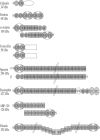The Arabidopsis cytoskeletal genome
- PMID: 22303225
- PMCID: PMC3243305
- DOI: 10.1199/tab.0096
The Arabidopsis cytoskeletal genome
Abstract
In the past decade the first Arabidopsis genes encoding cytoskeletal proteins were identified. A few dozen genes in the actin and tubulin cytoskeletal systems have been characterized thoroughly, including gene families encoding actins, profilins, actin depolymerizing factors, α-tubulins, and β-tubulins. Conventional molecular genetics have shown these family members to be differentially expressed at the temporal and spatial levels with an ancient split separating those genes expressed in vegetative tissues from those expressed in reproductive tissues. A few members of other cytoskeletal gene families have also been partially characterized, including an actin-related protein, annexins, fimbrins, kinesins, myosins, and villins. In the year 2001 the Arabidopsis genome sequence was completed. Based on sequence homology with well-characterized animal, fungal, and protist sequences, we find candidate cytoskeletal genes in the Arabidopsis database: more than 150 actin-binding proteins (ABPs), including monomer binding, capping, cross-linking, attachment, and motor proteins; more than 200 microtubule-associated proteins (MAPs); and, surprisingly, 10 to 40 potential intermediate filament (IF) proteins. Most of these sequences are uncharacterized and were not identified as related to cytoskeletal proteins. Several Arabidopsis ABPs, MAPs, and IF proteins are represented by individual genes and most were represented as as small gene families. However, several classes of cytoskeletal genes including myosin, eEF1α, CLIP, tea1, and kinesin are part of large gene families with 20 to 70 potential gene members each. This treasure trove of data provides an unprecedented opportunity to make rapid advances in understanding the complex plant cytoskeletal proteome. However, the functional analysis of these proposed cytoskeletal proteins and their mutants will require detailed analysis at the cell biological, molecular genetic, and biochemical levels. New approaches will be needed to move more efficiently and rapidly from this mass of DNA sequence to functional studies on cytoskeletal proteins.
Keywords: actin-binding proteins; intermediate filaments; kinesin; microfilaments; microtubule-binding proteins; myosin; plant proteome; tubulin.
Figures



Similar articles
-
Class-specific interaction of profilin and ADF isovariants with actin in the regulation of plant development.Plant Cell. 2007 Oct;19(10):3111-26. doi: 10.1105/tpc.107.052621. Epub 2007 Oct 12. Plant Cell. 2007. PMID: 17933902 Free PMC article.
-
Analysis of cytoskeletal and motility proteins in the sea urchin genome assembly.Dev Biol. 2006 Dec 1;300(1):219-37. doi: 10.1016/j.ydbio.2006.08.052. Epub 2006 Aug 26. Dev Biol. 2006. PMID: 17027957 Free PMC article.
-
Arabidopsis contains ancient classes of differentially expressed actin-related protein genes.Plant Physiol. 2002 Mar;128(3):997-1007. doi: 10.1104/pp.010906. Plant Physiol. 2002. PMID: 11891255 Free PMC article.
-
Molecular motors and their functions in plants.Int Rev Cytol. 2001;204:97-178. doi: 10.1016/s0074-7696(01)04004-9. Int Rev Cytol. 2001. PMID: 11243598 Review.
-
Phenotypes of cytoskeletal mutants.Curr Opin Cell Biol. 1993 Feb;5(1):129-34. doi: 10.1016/s0955-0674(05)80018-3. Curr Opin Cell Biol. 1993. PMID: 8448025 Review.
Cited by
-
+TIPs and microtubule regulation. The beginning of the plus end in plants.Plant Physiol. 2004 Dec;136(4):3855-63. doi: 10.1104/pp.104.051037. Plant Physiol. 2004. PMID: 15591443 Free PMC article. Review. No abstract available.
-
A role for F-actin in hexokinase-mediated glucose signaling.Plant Physiol. 2007 Dec;145(4):1423-34. doi: 10.1104/pp.107.108704. Epub 2007 Oct 26. Plant Physiol. 2007. PMID: 17965176 Free PMC article.
-
The microtubule plus-end binding protein EB1 functions in root responses to touch and gravity signals in Arabidopsis.Plant Cell. 2008 Feb;20(2):396-410. doi: 10.1105/tpc.107.056846. Epub 2008 Feb 15. Plant Cell. 2008. PMID: 18281505 Free PMC article.
-
Plant and mouse EB1 proteins have opposite intrinsic properties on the dynamic instability of microtubules.BMC Res Notes. 2020 Jun 22;13(1):296. doi: 10.1186/s13104-020-05139-6. BMC Res Notes. 2020. PMID: 32571413 Free PMC article.
-
Domestication over Speciation in Allopolyploid Cotton Species: A Stronger Transcriptomic Pull.Genes (Basel). 2023 Jun 20;14(6):1301. doi: 10.3390/genes14061301. Genes (Basel). 2023. PMID: 37372480 Free PMC article.
References
-
- Adams J, Kelso R, Cooley L. The kelch repeat superfamily of proteins: propellers of cell function. Trends Cell Biol. 2000;102(1)(1):17–24. - PubMed
-
- Altschul SF, Gish W, Miller W, Myers EW, Lipman DJ. Basic local alignment search tool. J Mol Biol. 1990;2152(3)(1):403–10. - PubMed
-
- Amos LA. Focusing-in on microtubules. Curr Opin Struct Biol. 2000;102(2)(1):236–41. - PubMed
-
- An Y-Q, McDowell JM, Huang S, McKinney EC, Chambliss S, Meagher RB. Strong, constitutive expression of the Arabidopsis ACT2/ACT8 actin subclass in vegetative tissues. Plant J. 1996;102(1):107–121. - PubMed
Grants and funding
LinkOut - more resources
Full Text Sources
Miscellaneous
